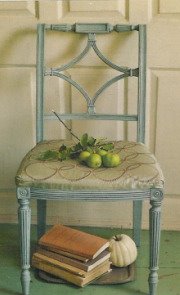
Believe it or not, the fantastic vignette you see above, featured in the late, great Cottage Living, came about with the designer's attempts to display a favorite plate collection. What developed is one of my favorite images from any magazine ever. Not only because I love every element in this space, but because the entire look spun off of a simple collection of white plates.
With the following images, and the series of posts to come, I'll show you how anything you collect can become a much-loved, personal feature of your home's decor.

Here's another collection of plates and platters taken out of the dining room and into the living room of a city townhouse. The symmetrical arrangement of the plates lends them a sense of formality and gives them the look of one unit. That they're all blue and white also helps them to read as one work of art rather than many individual pieces. If you've never thought of your plate collection as something you would hang on a wall, consider taking them out of your cupboards and china cabinets and give it a try. You've collected them because you love them—why not put them on display. For the best way I've found to hang plates, go to this post.

This homeowner, above, chose to display a collection of free form glass bowls on a wall rather than lining them up on a tabletop.
Something most of us have in our homes is a collection of photos. There are all kinds of "rules" about displaying photos. The two most common being (1) that all in a collection should be black and white or all should be color, but the two should not be mixed, and (2) that all should be framed in the same color and style. Now, I break the second rule all the time (for my own tabletop displays) but I rarely break the first. For a large wall display such as these, below, I think it's important to follow both.


A collection of black and white cityscapes is arranged above the wainscoting in an entry hall. The subject matter of the photos—architectural images with straight lines and crisp edges—dictates the rigid grid arrangement used here. The arrangement is softened considerably though by the way the designer chose to hang the top row but prop the bottom row on the wainscot's molding.
Notice too how the frames are arranged so that the aspect of every other is either horizontal or vertical. That took a lot of planning before framing, but the subtle effect and attention to detail was well worth the time and effort.
Notice too how the frames are arranged so that the aspect of every other is either horizontal or vertical. That took a lot of planning before framing, but the subtle effect and attention to detail was well worth the time and effort.

Another collection of black and white photos is given a much looser treatment, above, to great effect. While the subject matters vary wildly, the group is given cohesion by the use of all black frames and the tight arrangement in which they're hung.



In a previous post, I showed you my husband's collection of military photos. I thought it might be interesting to show you how I wrapped the collection around a corner as it was simply too large to hang on one wall. Notice that the frames are justified, or lined up, where the walls meet leaving only a small break between the two planes to allow the eye to view the collection as a whole. Please excuse the fuzzy photo and the fact that I've broken the "same frame" rule. Most are hung in the frames they came with and I believe the visual strength of the subject matter reduces the need for matching frames. I've also broken the "all black and white" rule with the colorful certificate of my husband's Naval service in Iceland. It fits the theme and makes the collection more personal.

If you have a very large space to fill, a cohesive collection like the ones above and below will do the job. The repetition of shapes, colors, subjects and framing style, give these many pieces the look and weight of a single, large piece of art. Notice too the different ways the two groups are arranged: the neutral-toned sketches, above, are hung in identical frames on a tight grid almost creating the effect of wallpaper or architecture. This arrangement perfectly suits the quiet, classical feeling of this room. The plein air paintings, below, being of differing sizes, are hung closely together but in a looser, oval arrangement, which not only suits the more casual atmosphere of this space, but the fluid lines of the landscapes they depict. Both collections are impressive and made even more so by the prominence they are given within their spaces.


Another collection of art in frames is this series of abstracts. The painter may not have meant for them to be a collection at all, simply color studies or practice pieces. Cut down to the same size and framed identically, they become a colorful, meaningful collection. You can do the same with a collection or your child's artwork, pages from a favorite illustrated book or a collection of wall calendar art.

If you have a very large space to fill, a cohesive collection like the ones above and below will do the job. The repetition of shapes, colors, subjects and framing style, give these many pieces the look and weight of a single, large piece of art. Notice too the different ways the two groups are arranged: the neutral-toned sketches, above, are hung in identical frames on a tight grid almost creating the effect of wallpaper or architecture. This arrangement perfectly suits the quiet, classical feeling of this room. The plein air paintings, below, being of differing sizes, are hung closely together but in a looser, oval arrangement, which not only suits the more casual atmosphere of this space, but the fluid lines of the landscapes they depict. Both collections are impressive and made even more so by the prominence they are given within their spaces.

A collection of framed botanicals, below, is hung in a space that can be quite awkward to decorate. Staggered as they are up the staircase wall, they fill the large space while still appearing as a unit held together by similarity of subject and coloration. That they also relate by color to the wall behind them helps them to recede into the wall visually rather than come forward in a way that might look messy and cluttered.

Another collection of art in frames is this series of abstracts. The painter may not have meant for them to be a collection at all, simply color studies or practice pieces. Cut down to the same size and framed identically, they become a colorful, meaningful collection. You can do the same with a collection or your child's artwork, pages from a favorite illustrated book or a collection of wall calendar art.

Three vintage botanical charts found at flea markets make a charming collection when hung together. Because of their size, you might be tempted to hang individual pieces like these on different walls, maybe even in different rooms thinking that they'll tie your spaces together. Please resist that temptation. Hanging them together like this maximizes their impact and each makes the other look better.

Much like a homemade quilt can contain favorite memories of childhood or ancestry through the use of meaningful textiles, so can a collection like the one below. Fabric remnants—pieces of clothing, tablecloths, embroideries— that by themselves have outlived their usefulness, can be framed, hung as a group and given new life. Loosely arranged as you see below, the display is casual but still has a lot of impact. Notice again what ties this collection together: identical black frames and the red and white coloration of the fabrics.

Do you have a collection of scarves or handkerchiefs tucked away in a drawer? Would you enjoy seeing them as part of your home decor? Frame them and hang them together. The graphic impact of a grouping of framed textiles is much the same as the impact of patterned plates. And just as you would with a plate arrangement, it's important to hang textiles that look good together and relate to each other whether through color or design or era.


Much like a homemade quilt can contain favorite memories of childhood or ancestry through the use of meaningful textiles, so can a collection like the one below. Fabric remnants—pieces of clothing, tablecloths, embroideries— that by themselves have outlived their usefulness, can be framed, hung as a group and given new life. Loosely arranged as you see below, the display is casual but still has a lot of impact. Notice again what ties this collection together: identical black frames and the red and white coloration of the fabrics.

Do you have a collection of scarves or handkerchiefs tucked away in a drawer? Would you enjoy seeing them as part of your home decor? Frame them and hang them together. The graphic impact of a grouping of framed textiles is much the same as the impact of patterned plates. And just as you would with a plate arrangement, it's important to hang textiles that look good together and relate to each other whether through color or design or era.

A collection of matchbook covers, below, has been mounted, matted and framed as wall art. Not only does the framing protect them from the wear of handling, it elevates their perceived importance and gets them out where they can be seen and appreciated. The same can be done with a collection of postcards, vintage business or calling cards—any small-sized paper ephemera that might otherwise languish in a drawer somewhere can gain new appreciation and stature when displayed like this.

Collections displayed on walls do not have to be items that fit into frames, as I've already shown you with plates and botanical charts and glass bowls. This collection of guitars is arranged in a way that is both practical and pleasing to look at—especially if you're the person who loves them.

On a recent episode of a new television series, I noticed a teenaged boys' room that had been decorated with a collection of skateboard decks. That seemed an appropriate place for such youth-oriented items. Here, however, notice how a large collection of humble, used decks has been given art gallery status in the way they're arranged in this hallway. I'm not sure whether this is a public or private space, but the photo serves to illustrate that virtually any collection, when properly displayed, can have terrific impact and add loads of visual interest to your home—especially when the subject of the collection is this unique and unexpected.

Even purely utilitarian objects, never meant to be decorative, take on the status of "art" when a collection is framed and presented as such. I'd like to imagine that these kitchen utensils belonged to the owner's grandmother and hold memories of long ago family gatherings.

In following posts, I'll illustrate how collections of many types can be put on display in various ways to become part of your home's unique personality. The great thing about decorating with collections is that you very likely already have a collection of some sort in your home. Barring the need to frame anything, you can achieve great impact with minimal expense and personalize your decor to the degree that store-bought wall art cannot. I hope this post has already given you some helpful ideas. Stay tuned for more...

Collections displayed on walls do not have to be items that fit into frames, as I've already shown you with plates and botanical charts and glass bowls. This collection of guitars is arranged in a way that is both practical and pleasing to look at—especially if you're the person who loves them.

On a recent episode of a new television series, I noticed a teenaged boys' room that had been decorated with a collection of skateboard decks. That seemed an appropriate place for such youth-oriented items. Here, however, notice how a large collection of humble, used decks has been given art gallery status in the way they're arranged in this hallway. I'm not sure whether this is a public or private space, but the photo serves to illustrate that virtually any collection, when properly displayed, can have terrific impact and add loads of visual interest to your home—especially when the subject of the collection is this unique and unexpected.

Even purely utilitarian objects, never meant to be decorative, take on the status of "art" when a collection is framed and presented as such. I'd like to imagine that these kitchen utensils belonged to the owner's grandmother and hold memories of long ago family gatherings.

In following posts, I'll illustrate how collections of many types can be put on display in various ways to become part of your home's unique personality. The great thing about decorating with collections is that you very likely already have a collection of some sort in your home. Barring the need to frame anything, you can achieve great impact with minimal expense and personalize your decor to the degree that store-bought wall art cannot. I hope this post has already given you some helpful ideas. Stay tuned for more...







































































































13 comments:
Great rundown on basics of displaying a collection. I've mounted gallery shows and you'd be surprised to learn that I am a big fan of the salon style.
This is a lovely post, Tracy! You're so right that a collection has so much more impact when it's displayed together rather than scattered throughout the house.
And I it's OK for frames not to match. In fact, I think it creates a lovely, organic quality that reads as less contrived/ "decorated" than matching frames.
Tracy,
I LOVE t his post...well done. I love the black and white walls and the DH's military photos. I like what you did with wrapping the wall around the corner, it IS a fabulous visual!
xx
I love that picture with the white plates ~ I think it's the symmetry that appeals to me. I'd like to have my family pictures redone in black and white and frame them to all hang together. I've seen where some other bloggers have done that and I think it looks great. When I have family pictures on a table or chest, I dont' always use the same frames or same type of frames either; I use what I've got or was given as a gift.
I loved this post, Tracy, as I have a lot of collectibles displayed in many ways in my home.
I have plates displayed in plate racks in my dining room, and I have family photo gallery going up my staircase wall. The frames are eclectic, but I think that makes the collection more interesting. I also have mirrored display cabinets for all the small collectibles that I own. It gives me joy to see these things everyday.
Hi Tracey,
This is a great post for me because I'm in the middle of re-doing my small salon wall over my sofa. I've taken everything down and painted the room white and have not put anything back up. I'm stuck. I don't know what to do so I'm looking forward to more posts relating to this. I do have a white plate collection that I've been thinking about displaying but I'm torn. Thanks for all this info.
~janet
A well researched and useful post. Very beautiful blog.
Wow so many great collection!!
I would have to say the plates are my favorite:)
Happy Fall
Love your post!
Have a blessed weekend!!!
KayEllen
Hi Tracy! Sorry it's taken me a while to get over here. I love this post, and it looks like our minds our running on the same track (although I announced mine a week ago and am just now getting to it! :-( Life!)I love all the examples that you've used. Hope you're having a great weekend...
I really need to do a grouping this some of these. Our new home is bigger than our last and we have a two story greatroom that will be a challenge to decorate. Plates in one area would be nice.
Lovely pics! Propping rather than hanging seems to have gained a big following recently. I confess I have done this with one small piece on my fireplace, but beyond that, the Bay Area risk of earthquakes has restrained me!
What a fabulous post...wish I had found it two hours ago, BEFORE I hung my flower prints in my bedroom. I think I followed the rules though and they came out okay. Will make sure I save this for future use. thanks!
the brown paper cut outs is a great trick, tho i always just use the lay it out on the floor technique, and then just eyeball it. i'm not afraid of a few extra nail holes either- it's why god invented spackle! (i do insist that if i'm doing this for a client, they not be home- clients aren't quite a relaxed about nail holes).
you've just saved a lot of people a lot of heartache with your post
Post a Comment